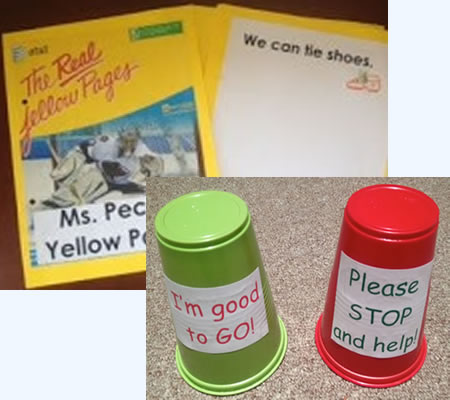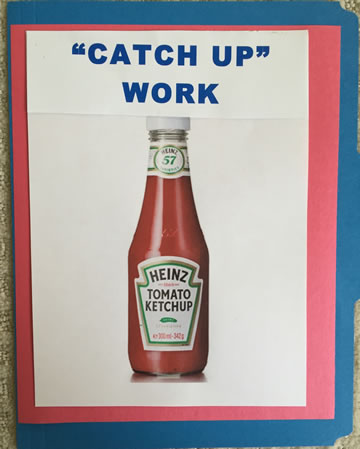Executive Function
Games
Games are a natural way to help children learn to follow rules, strategize, and cooperate.
•Have children bring games from home every Friday and end the day with 30 minutes of game time.
•Checkers, chess, Monopoly, and Clue require planning, sustained attention, working memory and self-control. Encourage parents to buy these games for their children and play WITH them at home.
Video Games
Problem solving video games can also develop attention, planning, organization, and persistence.
Note! Although I can think of better things to do, this is in the research.
I’ve Got a Feeling
Help children identify feelings (happy, sad, scared, etc.) and teach them coping mechanisms, such as deep breathing and slowly counting to ten.
•Provide a “happy place” in your classroom where children can escape if they are stressed or angry. You might put play dough, an iPod with soothing music, stuffed animals, books, a beanbag chair, etc. in the safe zone.
Role-Play
Demonstrate various alternatives for dealing with emotions and let children role-play what they could do. For example, what can you do when someone bullies you? What can you do when you are embarrassed?
Help Wanted
Make a “Class Yellow Pages” where students sign their names by activities where they can help classmates.
•Give students a red and green plastic cup to keep on their desk. The green cup should be on top unless they need help. The red cup will indicate to the teacher to “stop” and help.
Classroom Organization
Create separate areas of the classroom for different functions. For example, a classroom library, science table, a writing center, a lost and found, tubs for math manipulatives, etc. A place for everything and everything in its place will give children security and confidence.

Student Organization
Help students organize their work space and minimize clutter. An “office” similar to the one in the picture will encourage students to stay focused. They can put work completed in one pocket and things they need to finish in another pocket.
•Let students clean out each other’s desks with a partner every Friday.
Homework Folders
Prepare pocket folders similar to the one in the picture. Children take it home each night, complete the assignment, and get their parent’s signature.
•Hint! Save homework sheets for documentation.
Weekly Folders
Use weekly work folders to store children’s work. Each child can decorate a file folder and place it in a box. As they complete daily work they put it in their folder. The teacher grades the work and sends home the folder every Friday for parents to review with their child. You could also have a checklist in the folder with behaviors such as:
Finishes work on time.
Follows school rules.
Shows respect for others.
Takes care of works space and school materials.
Follows directions.
Student Numbers
Give each child a “special number.” Children label all their school materials with their number and put their number on all their work. They can also line up by their number.
•Hint! Start counting by “one” the first day. Start with “two” the second day so “one” is at the end of the line. Start with “three” on the third day and so forth.
Attention Grabbers
Use attention grabbers to focus children’s attention.
•Ring a bell.
•Blow bubbles.
•Blink the lights.
•1, 2, 3 – Eyes on me!
•Look. (Sign language L by eyes.)
Listen. (Sign language L by ears.)
Learn (Sign language L by brain.)
•Criss cross. (Children sit cross legged.)
Be your own boss! (Children cross arms.)
Watch Dr. Jean demonstration attention grabbers here:
https://www.youtube.com/watch?v=v5_W3mMfZvY
Daily Schedule
Post the daily schedule and review each morning and after lunch.
•Take photographs of the students engaged in the various activities and put them on 4” x 6” index cards. Attach magnetic tape to the front and back. As you do different activities turn them over so the children can follow the sequence of the day.
Classroom Calendar
Write birthdays, school events, and other special information on a classroom calendar. Count the days to holidays and demonstrate how to use time organizers to plan for special days.

Planning Journals
Each student will need a spiral notebook for a planning journal. Give them 5-10 minutes each morning to draw illustrations or write plans for the day.
Morning Meeting Routine
Sing a good morning song, give students a handshake, review the class rules, fill in the calendar, etc. Following the same routine each day will prepare students to “get ready” to learn.
Morning Mantra
Teacher: What is my job today?
Children: Your job is to teach us and to love us.
Teacher: What is your job today?
Children: Our job is to learn and to love each other.
Watch Dr. Jean demonstrate handshakes here:
https://www.youtube.com/watch?v=oaONx6N7-kM
Check Mate
Before starting a lesson, post a checklist of what students will need. As you read down the list, students respond, “Check!” if they are all set.
Pencils? – Check!
Paper? – Check!
Crayons? – Check!
Eyes Watching? – Check!
Ears Listening? – Check!
Hands and Feet Quiet? – Check!
“To Do” Lists and Contracts
Make daily checklists to help students stay on task. Long assignments can be overwhelming, but completing one step at a time is more manageable.
Fist List
When the teacher gives directions the students put up a finger for each step they are to follow.
Spelling Journal
Each week fold 3-5 sheets of paper in half (depending on the number of spelling words) and staple. Students do the following activities each day:
Monday – write a word on each page
Tuesday – write the definition
Wednesday – illustrate or cut out a picture
Thursday – write a sentence
Friday – take the book home and read to parents
Contracts
Give students contracts with different activities/centers/tasks listed. As they complete the tasks they can color in each section. Contracts could be done on a weekly basis or for a unit of study.
•You could also use a check off list, a tic-tac-toe frame, or a Bingo card.

Catch Up Folder
Students keep a “catch up folder” in their desk with work that needs to be completed.
Timer
Use a timer to encourage students to finish work and “beat” the timer.
Five Minute Person
Create a classroom job called “the five minute person.” When there are five minutes left on the playground, five minutes left in the lunch room, five minutes left in reading, etc. that person holds up five fingers and walks around the room saying, “Five more minutes. Five more minutes.”
Actions Speak Louder than Words
Model, model, model! Model writing, model reading, model how to put away materials, model how to say good morning, etc. Many children have no idea what you expect them to do if you don’t demonstrate it first.
Partner Pairs and Group Projects
Working with a classmate or in a group of 4 provides the opportunity for children to develop self-regulation, as well as 21st Century Skills. Here are a few projects students can do with a partner or small group.
Read together.
Retell a story. They can also discuss who, what, where, when, why, the problem, resolution, what might happen next, etc.
Whisper a prediction in each other’s ear.
Review information after a science lesson, social studies, etc.
Read around the room.
Write the room. Give them clipboards and ask them to write words that would reinforce a skill you are working on. For example, they could write compound words, words with the “th” diagraph, two syllable words, etc.
Write together. They could write a sentence, story, poem, song, observation, etc.
Play a board game.
Review flashcards.
Brainstorm! Make lists!
Do surveys and collect data.




